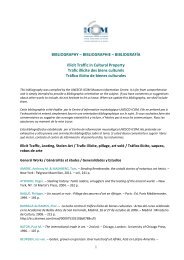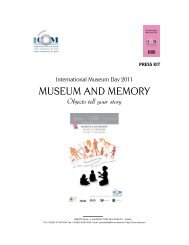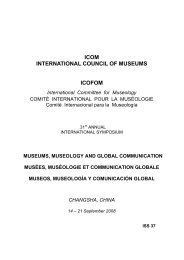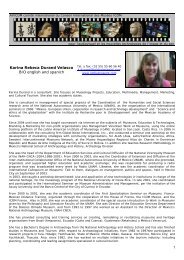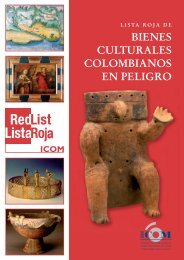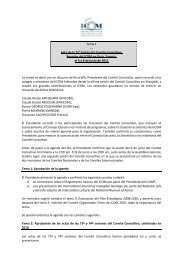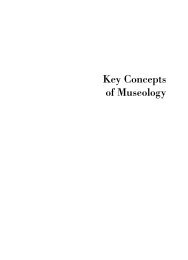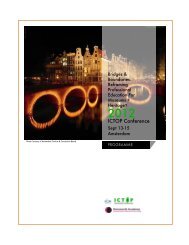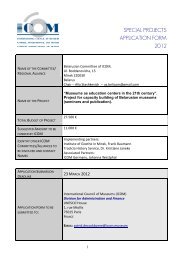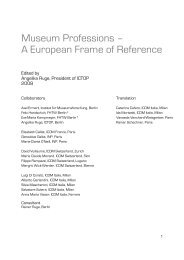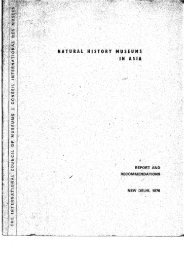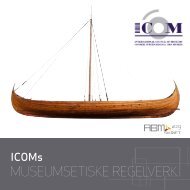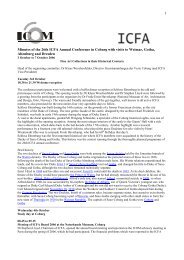ISS 25 (1995).pdf - The International Council of Museums
ISS 25 (1995).pdf - The International Council of Museums
ISS 25 (1995).pdf - The International Council of Museums
Create successful ePaper yourself
Turn your PDF publications into a flip-book with our unique Google optimized e-Paper software.
MUSEUMS AND COMMUNITY<br />
FINAL REMARKS<br />
(Mathilde Bellaigue)<br />
<strong>The</strong> core <strong>of</strong> the problem was to explore the threefold relation between the communjty (to<br />
define), our heritage which, whether in the museum or related to it, acts as a medium for that relation,<br />
and the museum itself.<br />
<strong>The</strong> community<br />
As a preambula, it appears necessary to give ourselves some theoretical bases: we have to<br />
distinguish between the anthropological acceptance <strong>of</strong> the word "commwtity" (a primary reference<br />
group characterized by its time, space, culture etc) and "commwtity" meaning a group <strong>of</strong> people<br />
taking position. <strong>The</strong> former one is commonly concerned by the museum.<br />
A commwtity, as a group <strong>of</strong> persons interacting with their environment, manipulating its<br />
resources, having social, economical, esthetical codes, and leaving their own traces as their<br />
expression, is continually shifting.<br />
But the "commwtity" can also be considered from the point <strong>of</strong> view <strong>of</strong> the museum, as a<br />
social and cultural group that wants to be in a dialectical and active relation with the museum.<br />
<strong>The</strong> heritage as a medium<br />
<strong>The</strong> museum is constituted <strong>of</strong> remaining things (our traces) that we choose to keep as our<br />
heritage. <strong>The</strong> functions <strong>of</strong> heritage have to be precised :<br />
- museum collections are not an end but a mean<br />
- heritage is not an identity but a reference<br />
- there is a relativity in collections : what is inside the museum is <strong>of</strong>ten strange to the society<br />
around that museum.<br />
If what is preserved is submitted to criticism (the museologist's choice), there is no effective<br />
criticism <strong>of</strong> that choice. However such a critical stage would in fact be the sign <strong>of</strong> modernity, the<br />
moment when we choose what we want to keep from our traces. (That is why destroying the cultural<br />
traces <strong>of</strong> a commwtity is the base <strong>of</strong> eUmocide : it both cuts the thread from the past, therefore<br />
annihilates the memory, and deprives the community from an instrument to organize its future).<br />
<strong>The</strong> museum<br />
<strong>The</strong> museum is altogether a place, a tool and a symbol for the preservation and restoration <strong>of</strong><br />
the memory. History gives birth to material and immaterial heritage. Museology helps us to manage<br />
the burden <strong>of</strong> the past in museums.<br />
Through the different museal stages, the objects acquire successive and different meanings.<br />
Objects <strong>of</strong> to-day are supposed to represent the present truth. At every moment we can change the<br />
construction, not only <strong>of</strong> the museum, but <strong>of</strong> history. but <strong>of</strong> memory. <strong>The</strong> museum has not to "take<br />
the colour <strong>of</strong> the community". For true relations lie upon alterity which is the base <strong>of</strong> dignity.<br />
123



